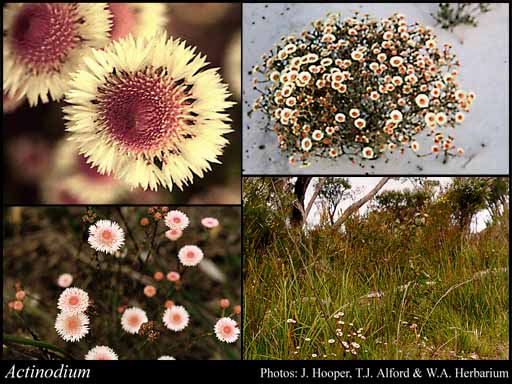- Reference
- Linnaea 10:311 (1836)
- Name Status
- Current

Scientific Description
Common name. Albany Daisies. Family Myrtaceae.
Habit and leaf form. Shrubs; evergreen; bearing essential oils. Plants with neither basal nor terminal concentrations of leaves; to 1 m high. Leptocaul. Helophytic, or mesophytic. Leaves minute to small; alternate; ‘herbaceous’, or leathery; petiolate, or subsessile, or sessile; gland-dotted; aromatic; edgewise to the stem, or with ‘normal’ orientation; simple; epulvinate. Leaf blades dorsiventral, or isobilateral, or centric; entire; solid; terete; linear, or lanceolate, or oblong, or ovate; linear to elliptic; pinnately veined, or parallel-veined, or one-veined; cross-venulate, or without cross-venules. Leaves without stipules; without a persistent basal meristem. Stem anatomy. Secondary thickening developing from a conventional cambial ring.
Reproductive type, pollination. Fertile flowers hermaphrodite (or sterile). Unisexual flowers absent. Plants hermaphrodite. Entomophilous, or ornithophilous. Pollination mechanism conspicuously specialized, or unspecialized.
Inflorescence and flower features. Flowers aggregated in ‘inflorescences’; in racemes. Inflorescences simple, or compound. The terminal inflorescence unit cymose. Inflorescences terminal; condensed, flat across the summit, resembling a daisy head with inner, bisexual disc flowers and outer, sterile ray flowers, very rarely lacking the ray flowers; with involucral bracts (which intergrade with the leaves); pseudanthial. Flowers pedicellate; bracteate; (bi) bracteolate; minute to medium-sized; regular; 4 merous; cyclic. Free hypanthium present (petals ‘inserted on the calyx’); acutely 4-angled. Hypogynous disk present. Perianth with distinct calyx and corolla; 8; 2 -whorled; isomerous. Calyx present; 4; 1 -whorled; polysepalous; imbricate, or valvate; more or less equalling the corolla; persistent. Sepals linear. Corolla present; 4; 1 -whorled; polypetalous; imbricate; regular; plain; green, or white, or red to pink; persistent. Petals ovate, or linear. Androecial members definite in number. Androecium 8. Androecial sequence determinable, or not determinable. Androecial members free of the perianth; markedly unequal (those opposite the sepals longer); coherent; 1 - adelphous (connate into a short tube); 1 -whorled. Stamens 8; attached on the rim of the hypanthium; becoming exserted; diplostemonous; alternisepalous and oppositisepalous; both opposite and alternating with the corolla members; erect in bud, or inflexed in bud. Anthers dorsifixed; versatile; dehiscing via pores (pores terminal); introrse; tetrasporangiate; appendaged, or unappendaged. Gynoecium 2 carpelled. The pistil 1 celled. Gynoecium syncarpous; synstylovarious to eu-syncarpous; inferior, or partly inferior. Ovary unilocular; 1 locular. Epigynous disk present, or absent. Gynoecium stylate. Styles 1; apical; becoming exserted; with papillae below the stigma. Stigmas 1. Placentation parietal. Ovules in the single cavity 1; ascending (on intrusive placentas); non-arillate; anatropous.
Fruit and seed features. Fruit non-fleshy; indehiscent; a nut; 1 celled; 1 seeded. Seeds non-endospermic; winged, or wingless. Cotyledons 2.
Geography, cytology, number of species. Native of Australia. Endemic to Australia. Australian states and territories: Western Australia. South-West Botanical Province.
Etymology. From the Greek meaning like a ray or spoke of a wheel.
Keys
A Key to Western Australian Species in the Chamelaucieae Tribe of Myrtaceae
B.L. Rye, M.D. Barrett, T.D. Macfarlane, N.S. Lander, M.E. Trudgen, N.G. Marchant, K.R. Thiele